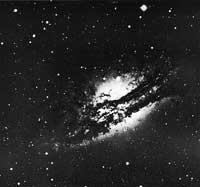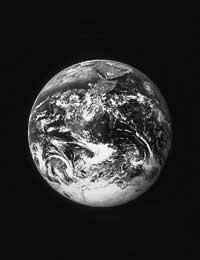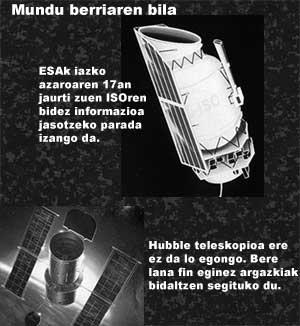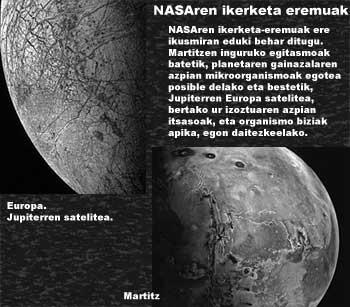Is there anyone out there?

Throughout his entire history, man has looked to heaven in search of extraterrestrial life. Today, once the planets that revolve around the Sun have been analyzed and discarded, science is immersed in this search. But until recently it has not taken the step of approaching the answer, that is, no planet was known outside the solar system. And that is precisely what they have managed to change in October 1995 at the Geneva Observatory in Switzerland: The team led by Michel Mayor and Didier Queloz discovered a planet around star 51 Pegasi, located 45 light-years, in the constellation of Pegasus.
This object has half the mass of Jupiter and its orbit around its star is smaller than that of Mercury around the Sun. Consequently, it is estimated that the temperature on its surface is about 1,300ºC. Too hot for liquid water.
However, the news that has put dancing emails around the world came two months later. In the two stars closest to the Solar System, astronomers have unveiled two other planets that are apparently warmer, so it is possible that in them water is in liquid state and biologists say that this is the necessary condition for life to exist. Liquid water is the ideal means to dissolve carbon-based organic chemicals and react to each other in a thousand different ways. And why carbon? Because it is able to form different and complex components, on the one hand, and on the other, because it is in the Universe everywhere.

Geoffrey Marcy and Paul Butler, who work at the University of San Francisco State, unveiled the discovery and explained it at the American Astronomy Society winter congress held in the city of San Antonio in Texas in January. The aim of both astronomers is to investigate 120 stars and then have investigated about 60. It would not be surprising, therefore, that in the coming months or years more planets were found and, therefore, that the exploration of space borders was accelerated.
The first discovered planet is 35 light years, 47 in the star Ursae Majoris and is double that Jupiter. The giant planet is made up of hydrogen, ammonia and methane sulphides, in which intense wind currents constantly move at a speed of hundreds of km/h, forming impressive spiral wind storms with enough force to swallow the Earth that will circulate over the centuries. If there were solid earth in this planetarium, it would be buried under an atmosphere of thousands of kilometers, trodden and trodden by pressures not even in the deepest sea on Earth.

It is also understandable that you have less desire to visit the second planet. The newly discovered planet is circling the 70 Virginis star of the constellation of Virgo, six times greater than Jupiter, so scientists believe that weather conditions may be more unsustainable than those of the previous planet.
However, more important than all this is the characteristic we have already mentioned, that is, that on those planets there can be liquid water. And the question that comes to mind is: Is there life on those other worlds? At present we cannot answer. However, if it is not on giant planets, there may be smaller planets in those systems that meet the living conditions we know. Or that these great planets are satellites, fit for life, apika. Who knows.
Origins Program
If we look for life outside the earth, it is lawful to think that we would find it in objects that would look like our planet, and behind it are those who work on the Origins program. Considering that in our galaxy there are 100,000 million stars, this project, led by Daniel Goldin and Edward Weiler of DNA, aims to locate and photograph Earth-like planets that may be outside the solar system.
This is an ambitious goal, because if we compare these objects with their stars, they are fragile. The only way to achieve this would be to build a telescope with a mirror of the width of a football field, but with current technology, doing so is unthinkable. However, astronomers know perfectly well that this giant telescope can be replaced by many other small ones, moving away from each other and electronically combining the light of all, forming an interferometer.

This is not very expensive and at the beginning of the next century a structure of 4 or 6 mirrors of 30 x 60 cm will be in operation. With this width, the interferometer will be able to detect objects of the size of Neptune that can be found in the surrounding stars. And in 2010, NASA intends to launch the Planet Finder, an interferometer that will move orbating in the Jupiter area (5 mirrors 1 x 2 m wide along 90 m) taking advantage of the decrease of dust and debris of the solar system in those areas. This will show us as blue dots structures similar to Earth and the information it will send to Earth will allow us to analyze its atmosphere.
Before this becomes a reality, also through the ISO (Infrared Space Observatory) launched by the ESA (European Space Agency) on 17 November, we will have the opportunity to receive information by recording the thermal waves of the planets that are far from us. As he analyzes the wavelengths in the infrared, on February 3 he achieved, among other things, the spectacular clash between two galaxies called Antennae. In addition, the Hubble Telescope will continue to send photographs that demonstrate the greatness of the Universe, photographing galaxies, stars, planets and huge clouds of gas, as before.
In search of alien intelligence
Thus, some seek planets and others seek directly an intelligent life. The first was Frank Drake (Intelligent Life in Space, 1962 and the Ozma project, 1960). With this work he directed a radio telescope to the t Ceti and e Eridani stars, 11 light-years, in order to collect possible radio signals from external civilizations. The other SETI (Search for Extra-Terrestrial Intelligence) projects that have been organized since then have also not been successful to date.

Without forgetting all this, within our solar system we must take into account projects that in the future may be NASA research areas. On the one hand, we must take into account the projects of Mars, since it is possible the presence of microorganisms under the surface of the planet, and on the other hand, we will have to study the satellite Europe of Jupiter, since under the icy water of the place can be the seas, and living organisms, apika.
However, finding an intelligent life is the most attractive and exciting idea. Such findings would not only affect biology but directly affect practically all areas of knowledge. This would radically change our view of the universe and we should review and review each and every principle we have built over time. Do not hesitate. But that's reader, it's something very different.
Buletina
Bidali zure helbide elektronikoa eta jaso asteroko buletina zure sarrera-ontzian











